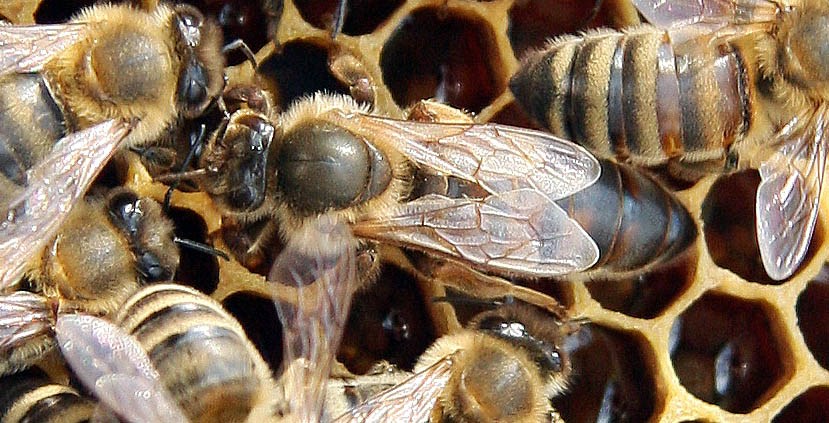PA Queen Bee Improvement Project

"Instructions for Participating in FNE18-886-“PA Queen Bee Improvement Project- field test for Mite-biting Behavior using Backyard Scientists”"
Would you like to be part of history and participate as a ‘Backyard Scientist’ studying Purdue Leg-Chewers ?
Varroa mites are the single greatest threat to sustainable beekeeping in the Northeastern US, and across the world. Despite extension efforts to convince backyard beekeepers to monitor and treat using known safe miticides, most hobbyist beekeepers (~60%) chose inaction/wishful thinking resulting in their colony losses to be about twice that of commercial beekeepers (beeinformed.org). So, changing beekeeper behavior is as important as methods to manage Varroa.
Now, a new novel genetic trait described by Dr. Greg Hunt from Purdue University is Mite-Biting Behavior (MBB), aka ‘Purdue Leg-chewers’. The MBB trait is when the honeybees bite off one or more legs from a varroa mite; bitten mites will then bleed to death.
Field work in a 2015 SARE grant which measured the relationship of MBB to the total mite count, we found they had better overwintering success. Further work, during 2017 SARE, discovered that the Purdue stock made more honey than the other test groups. Increased winter survival and honey production both increase sustainability of beekeeping, by reducing replacement costs of dead bees and increased profits from honey sales.
Our objective is to change the behavior of 100 hobbyist beekeepers by having them compare colonies with queens from a Purdue MBB/mite-resistant stock versus Control stock.
We are recruiting hobbyist beekeepers from our local bee clubs in several states. To participate, we want you to have more than 2 years beekeeping, have hives registered w/the state, currently own bees, and are part of bee club which can support you if you need help.
How it works, and what do you have to do.
Acquisition of Your Queens: In early June 2018 you will receive 2 queens, one mite resistant/ MBB queen and second from a Control group. You will pick up your queens at your bee club, or make arrangements. The Control group queens will be from commercial queen producers in the Southern and Western US which are not selected for any mite resistance. The queens will be marked with either paint or a number disc glued to them. You will not know which queen is MBB and which is the Control.
Splitting Your Colonies: You will take one of your existing full colonies, remove its queen, and evenly split the colony into two queenless colonies. The queenless colonies will be left that way for 24-48 hours, prior to introducing the 2 project queens. Standard practices will be used by the participants for splits and requeening. This is where the bee clubs come in handy!
Data that you will need to collect.
The colonies will then be managed equally throughout the growing season. After the end of the fall honey flow, the colonies will be surveyed for:
(1) Mite counts on bottom “sticky” boards after a 24 – 48 hour drop. If 10 mites are not present after 48 hours, the drop will be extended to a 5 day drop for both hives.
(2) All mites on the “sticky” boards will be viewed using a 15X or better magnifying glass. The number of mites with legs missing or other evidence of chewing will be recorded.
(3) The chewing percentage will be calculated by dividing the number chewed by the total mite count for each colony.
(4) The colonies will be weighed and the weights recorded.
(5) An alcohol wash will be made using the industry standard method of collecting a half a cup of bees (approximately 300 bees), and washing w/alcohol, then counting the mites in the liquid. The total mites and mites/100 bees will be recorded. Instructions and video demonstrations are available at Honeybee Health Coalition (https://honeybeehealthcoalition.org/varroa/). See the sampling methods video and the downloadable Varroa Management Guide. This is an excellent chance for you to learn new things, and change your beekeeping management for the better.
a. The participants are encouraged to perform additional mite counts throughout the season and report the results with the date of the test, total mites, and mites/100 bees.
(6) If mite monitoring indicates a colony should be treated, both hives shall be treated with the same treatment.
How to look for chewed mites.
Data collection procedures-Mite count and chewing percentage of mites in the field by beekeepers is simple:
(1) An oiled “sticky” board is inserted under the screened bottom board or over the solid bottom board (floor) of the colony,
(2) The board is allowed to remain for 24-48 hours.
(3) The mite boards are removed from the colonies, and brought to safe processing area/lab.
(4) Sift through the contents on the “sticky” boards and collect the dark mature mites taking care not to damage them.
(5) Glue/set the mites “legs up” on a glass microscope slide/petri dish, and count the total number.
(6) View each mite on the slide under a low power microscope/15X-handlense and count how many mites have chewed/missing legs.
(7) Calculate the MBB percentage, example: 12 chewed mites/ 36 total = 33%.
The collection process is simple for beekeepers to collect in the field with minimal training and tools. The evaluation component, steps 4-7, is more skilled, labor intensive and time consuming. Fortunately it can be done later as time allows by the beekeeper, or can be brought to a more experienced bee keeper in the club, or at a workshop.
Winterizing Colonies:
The colonies will be prepared for winter based on your standard practices, and the colony will be overwintered. If the colony lives until mid-March it will considered a survivor.
